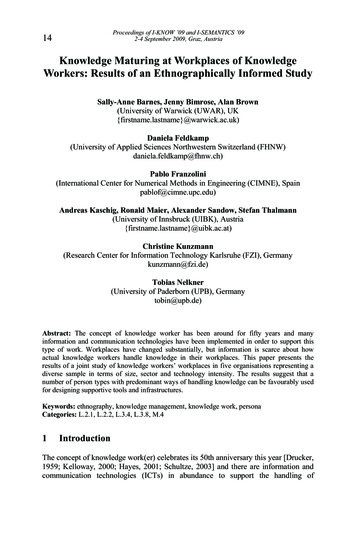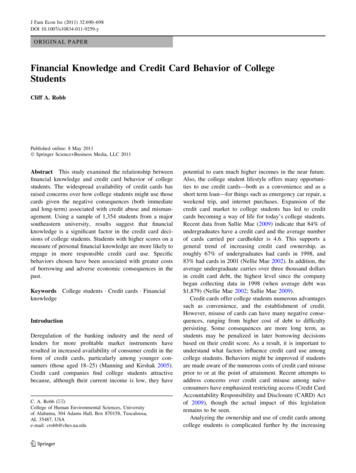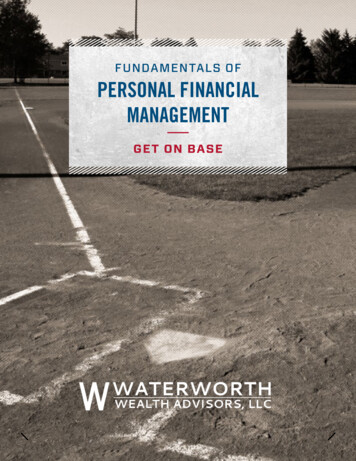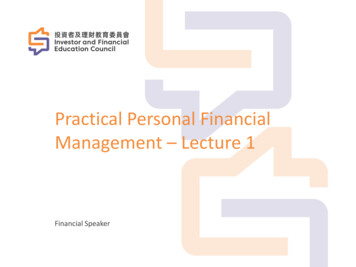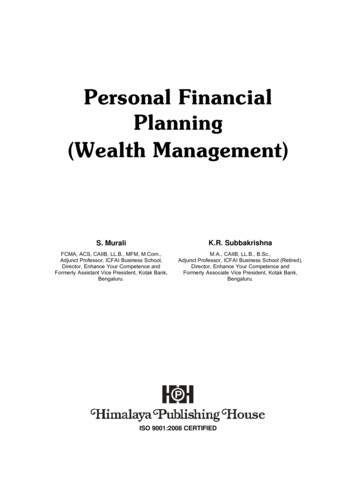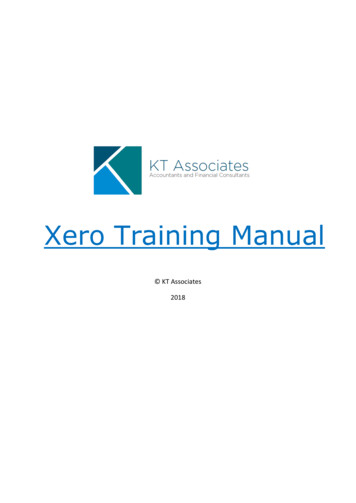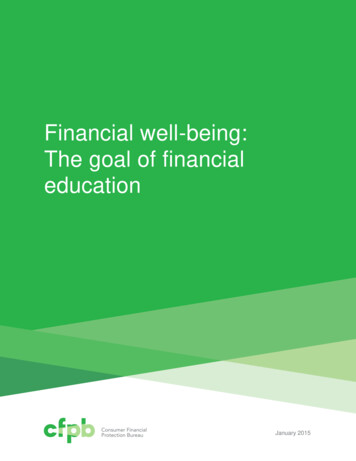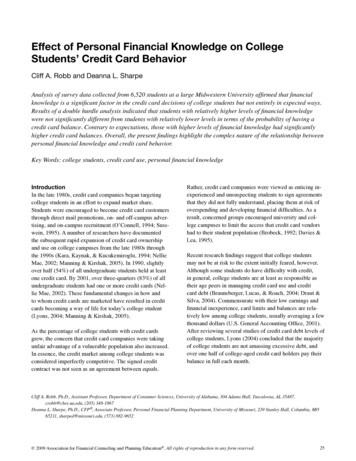
Transcription
Effect of Personal Financial Knowledge on CollegeStudents’ Credit Card BehaviorCliff A. Robb and Deanna L. SharpeAnalysis of survey data collected from 6,520 students at a large Midwestern University affirmed that financialknowledge is a significant factor in the credit card decisions of college students but not entirely in expected ways.Results of a double hurdle analysis indicated that students with relatively higher levels of financial knowledgewere not significantly different from students with relatively lower levels in terms of the probability of having acredit card balance. Contrary to expectations, those with higher levels of financial knowledge had significantlyhigher credit card balances. Overall, the present findings highlight the complex nature of the relationship betweenpersonal financial knowledge and credit card behavior.Key Words: college students, credit card use, personal financial knowledgeIntroductionIn the late 1980s, credit card companies began targetingcollege students in an effort to expand market share.Students were encouraged to become credit card customersthrough direct mail promotions, on- and off-campus advertising, and on-campus recruitment (O’Connell, 1994; Susswein, 1995). A number of researchers have documentedthe subsequent rapid expansion of credit card ownershipand use on college campuses from the late 1980s throughthe 1990s (Kara, Kaynak, & Kucukemiroglu, 1994; NellieMae, 2002; Manning & Kirshak, 2005). In 1990, slightlyover half (54%) of all undergraduate students held at leastone credit card. By 2001, over three-quarters (83%) of allundergraduate students had one or more credit cards (Nellie Mae, 2002). These fundamental changes in how andto whom credit cards are marketed have resulted in creditcards becoming a way of life for today’s college student(Lyons, 2004; Manning & Kirshak, 2005).As the percentage of college students with credit cardsgrew, the concern that credit card companies were takingunfair advantage of a vulnerable population also increased.In essence, the credit market among college students wasconsidered imperfectly competitive. The signed creditcontract was not seen as an agreement between equals.Rather, credit card companies were viewed as enticing inexperienced and unsuspecting students to sign agreementsthat they did not fully understand, placing them at risk ofoverspending and developing financial difficulties. As aresult, concerned groups encouraged university and college campuses to limit the access that credit card vendorshad to their student population (Brobeck, 1992; Davies &Lea, 1995).Recent research findings suggest that college studentsmay not be at risk to the extent initially feared, however.Although some students do have difficulty with credit,in general, college students are at least as responsible astheir age peers in managing credit card use and creditcard debt (Braunsberger, Lucas, & Roach, 2004; Draut &Silva, 2004). Commensurate with their low earnings andfinancial inexperience, card limits and balances are relatively low among college students, usually averaging a fewthousand dollars (U.S. General Accounting Office, 2001).After reviewing several studies of credit card debt levels ofcollege students, Lyons (2004) concluded that the majorityof college students are not amassing excessive debt, andover one half of college-aged credit card holders pay theirbalance in full each month.Cliff A. Robb, Ph.D., Assistant Professor, Department of Consumer Sciences, University of Alabama, 304 Adams Hall, Tuscaloosa, AL 35487,crobb@ches.ua.edu, (205) 348-1867Deanna L. Sharpe, Ph.D., CFP , Associate Professor, Personal Financial Planning Department, University of Missouri, 239 Stanley Hall, Columbia, MO65211, sharped@missouri.edu, (573) 882-9652 2009 Association for Financial Counseling and Planning Education . All rights of reproduction in any form reserved.25
Questions remain, however, as to what factors enable college students to manage credit card use despite their relative inexperience in the credit market. Economic theoryproposes that consumers require knowledge to make utility maximizing choices. The purpose of this study was toexamine the role that knowledge of personal finance concepts and principles may play in college students’ decisionto revolve a credit card balance and in the level of balancerevolved. In this study, credit card revolvers were definedas respondents who did not pay their credit card balancein full at the end of the month. Study findings can broadenthe understanding of factors influencing student credit carduse and may be useful for consumer educators and policymakers that are interested in helping college students learnhow to manage credit effectively.Review of LiteratureCredit Card Usage Among College StudentsDemographic Trends:A number of recent studies have examined the characteristics, attitudes, and behaviors of college students who usecredit cards (see Lawrence, Christofferson, Nester, Moser,Tucker, & Lyons, 2003 as well as Lyons, 2004 for a review of this research). These studies reveal some generaltrends about college students and credit card use. Genderdifferences in credit card use exist. Female students weremore likely than male students to have a credit card (Armstrong & Craven, 1993; Lawrence, et al., 2003). Typically,they also held more debt than male students (Micomonaco, 2003). In prior research, females have tended todisplay lower scores than males on measures of personalfinancial knowledge (Chen & Volpe, 1998, 2002; Jones,2005; Lusardi & Mitchell, 2005; Borden, Lee, Serido, &Collins, 2008).Evidence suggests that there is little difference in terms ofcredit card ownership based on college students’ ethnicity. In a study of Louisiana college students, Lawrence etal. (2003) noted that 45% of card holders were Caucasian,23% were African American, 19% were Asian, about 6%were Hispanic and the remainder were Native Americanor other race and ethnicities. These percentages reflectedthe race and ethnic distribution in the overall student body,suggesting that ethnicity was not a factor in distributionof credit card holders on that campus. There is some priorresearch, however, that indicated that minority students aremore likely to be financially at risk when compared withother students (Lyons, 2004).26Parental income is a key indicator of a student’s accustomed lifestyle, social class, resources and opportunityto learn about management of money. According to onereport, about 14% of students came from families with anannual household income under 50,000 (Draut & Silva,2004). Draut & Silva (2004) found that students fromlower income households were more likely to developrelatively high credit card balances ( 7,000 or more) ascompared with their peers. These findings suggest thatperhaps such students did not have as much experience infinancial markets as their peers from middle- and high-income families.Several studies have linked attitudes toward credit withcredit behavior in several studies. Higher affective creditattitude scores (using measures such as “my credit cardmakes me feel happy,” or “I like using my credit card”)have been associated with students carrying an outstandingbalance on multiple cards (Hayhoe, Leach, Turner, Bruin,& Lawrence, 2000). Similarly, Xiao, Noring, and Anderson (1995) and Joo, Grable, and Bagwell (2003) found thata positive attitude toward credit cards was associated withcard ownership and use. Chien and DeVaney (2001) noteda positive connection between attitudes towards creditand the likelihood of carrying a balance. After examining credit card attitudes among undergraduates in Britainand America, Yang, James, and Lester (2005) concludedthat affective and behavioral attitude scores were thestrongest predictors of the number of credit cards owned.Interestingly, they noted that those who had more positiveattitudes toward money in general also exhibited greaterobsession with money.Hayhoe, Leach, and Turner (1999) developed a scalemeasure of money attitudes using survey participant’sresponses to statements about feelings, knowledge, andbehavior related to credit cards and debt. Evaluating the relationship between this measure and college student creditcard behavior, they found that students’ scores regardingmoney attitudes of obsession and retention and affectivecredit attitudes distinguished between the students who didand did not have credit cards (Hayhoe et al., 1999). Attitudinal scores also distinguished between students who hadless than three credit cards and those with four or more andwere significant predictors of who, among students withcards, would carry four or more credit cards.There seems to be some “class rank” effects in credit cardbehavior. A study by Nellie Mae (2002), a nonprofit stu-Journal of Financial Counseling and Planning Volume 20, Issue 1 2009
dent loan provider, found slightly more than half of freshmen (54%) had a credit card. Freshmen also had the lowestaverage number of cards (2.5) and average debt ( 1,533).The numbers of cardholders rose with class rank, however.Ninety-two percent of sophomores had a card; for seniorsthe percentage was ninety-six. From sophomore to senioryear, the average number of cards held was successivelylarger, changing from 3.67 to 4.50 to 6.13, respectively.Average debt levels were larger for higher levels of classrank as well. The average debt of seniors ( 3,262) wasmore than double that of freshmen (Nellie Mae, 2002).Similar to seniors, 96% of graduate students reported owning at least one card; on average, they had 6 credit cards. At 7,831 per student in 2003, the average credit card debt ofgraduate students was much higher than that of undergraduates. The average level of credit card debt among graduatestudents in 2003 was almost 3,000 higher than reportedin 1998 (Nellie Mae, 2007). One in four graduate studentswith credit card debt in 2003 had balances between 6,000and 15,000, about the same proportion observed in 1998.Fifteen percent had a balance over 15,000, over twice theproportion seen in 1998 (Nellie Mae, 2007).Lyons (2004) analyzed responses from a random sample ofUniversity of Illinois undergraduate and graduate studentswho had completed a survey related to financial issues in2001 to determine the probability of being at risk of creditmisuse or mismanagement as measured by four specificoutcomes or behaviors: having 1,000 or more in outstanding credit card balances, being late on payments by twomonths or more, having reached the limit on credit cards,and rarely or never paying off credit card balances. Lyons(2004) concluded that financially at-risk students weremore likely than other students to receive need-based financial aid, have 1,000 or more in other outstanding debt,or to have acquired their card by mail, at a retail store or asthe result of a campus solicitation.Graduating students leave college and university campuseswith an average debt burden of 20,402 for education andcredit card debt combined (Nellie Mae, 2002). Financialexperts have expressed concern that credit card debt coupled with student loan debt could create serious financialburdens for college students near and post graduation(Bianco & Bosco, 2002; College Board, 2005). Theseconcerns have only intensified in recent years as rising tuition costs have consistently outpaced increases in financialaid available per student (College Board, 2005). UniversityJournal of Financial Counseling and Planning Volume 20, Issue 1 2009administrators who were contacted as part of a study onstudent credit card use commissioned by the General Accounting Office have acknowledged that there may be arelationship between various financial concerns, including mishandling of credit, and persistence to graduation(GAO, 2001).Financial KnowledgeThere are two lines of research on financial knowledge.In one group of studies, participants answered questionsrelated to general financial knowledge (Markovich & DeVaney, 1997; Chen & Volpe, 1998; Avard, Manton, English,& Walker, 2005; Jones, 2005). The questions used in thesestudies related closely to the topics typically covered in anintroductory personal finance course. The second group ofstudies used specific financial knowledge as a proxy forfinancial literacy (Warwick & Mansfield, 2000; Joo et al.,2003; Braunsberger et al., 2004). These studies generallyasked individuals to report particular facts about their owncredit cards (e.g. APR, fees, etc.). There is strong evidencefrom both lines of research that suggests, regardless ofhow financial knowledge is operationalized, college students do not possess a high degree of financial knowledge(Markovich & DeVaney, 1997; Chen & Volpe, 1998; Warwick & Mansfield, 2000; Avard et al., 2005; Jones, 2005).Chen and Volpe (1998) administered a 36 question surveydealing with various aspects of personal financial knowledge to college students. The average score of correct responses was close to 53%, not a passing score on a typicalgrading scale. They noted significant degree-type and classrank effects. Business majors tended to score better thannon-business majors. Students with more years of collegehad higher financial knowledge scores than students withfewer years of college. Other researchers have also foundthat college freshmen have low scores on tests of financialknowledge. Avard et al., (2005) found that college freshmen were able to answer only about 35% of financialknowledge questions correctly. Using a six-question scaleof credit knowledge to evaluate financial knowledge, Jones(2005) reported that, on average, incoming freshmen gavecorrect answers only 56% of the time.Among existing studies, the ability of a cardholder toreport his or her annual percentage rate (APR) is one ofthe most commonly used measures of specific financialknowledge. The federal law mandating reporting of theAPR was passed in 1968. Since that time, awareness ofAPRs has grown considerably (Durkin, 2000; Hogarth27
& Hil
ing credit card balances, being late on payments by two months or more, having reached the limit on credit cards, and rarely or never paying off credit card balances. Lyons (2004) concluded that financially at-risk students were more likely than other students to receive need-based fi-nancial aid, have 1,000 or more in other outstanding debt, or to have acquired their card by mail, at a .

